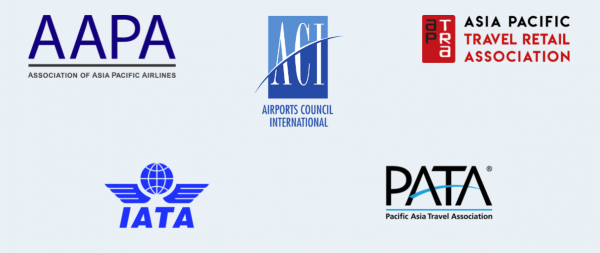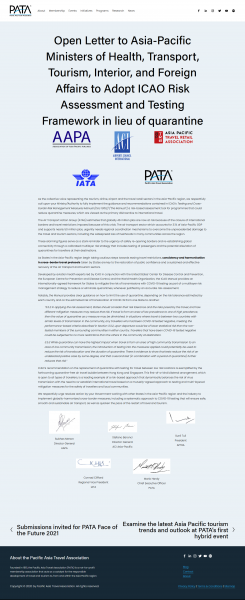SINGAPORE, 7 December 2020: Asia’s top travel trade associations are calling on the region’s governments to adopt measures outlined in an ICAO manual to ease quarantine rules that are crippling tourism economies.
Backing the call for action the following associations signed off on the Open Letter: Association of Asia Pacific Airlines; Asia Pacific Travel Retail Association; International Air Transport Association; Pacific Asia Travel Association and Airports Council International.

They are asking governments to recognise that the ICAO manual offers an alternative path to quarantine measures that could save jobs and livelihoods.
The five association CEOs penned an Open Letter to Asia-Pacific Ministers of Health, Transport, Tourism, Interior, and Foreign Affairs over the weekend asking them to adopt the International Civil Aviation Organisation’s “Risk Assessment and Testing Framework instead of quarantine.”
“As the collective voice representing the tourism, airline, airport and the retail travel sectors in the Asia-Pacific region, we respectfully call upon your Ministry/Authority to fully implement the guidance and recommendations contained in ICAO’s Testing and Cross-border Risk Management Measures Manual, a risk-based assessment tool for programmes that could reduce quarantine measures, which are viewed as the primary disincentive to international travel.”

It is arguably the first example of the five top travel trade associations joining forces to present their case to government in the Asia Pacific. They are recommending governments to adopt a single set of measures that could replace quarantine and provide more clarity for travel consumers. The timing is right as countries are now presenting timetables for the introduction of vaccines possibly by mid-2021. The UK that introduced the first batch of 800,000 vaccine doses last week while experts are now cautiously optimistic there is now a light at the end of the tunnel.
The joint statement reads: “As States in the Asia-Pacific region begin taking cautious steps towards easing travel restrictions, consistency and harmonisation in cross-border travel protocols taken by States are key to the restoration of public confidence and a sustained and effective recovery of the air transport and tourism sectors.”
Developed by aviation health experts led by ICAO in conjunction with the United States’ Center for Disease Control and Prevention, the European Centre for Prevention and Disease Control, and the World Health Organization, the ICAO Manual provides an internationally-agreed framework for States to mitigate the risk of transmissions with COVID-19 testing as part of a multilayer risk management strategy to reduce or eliminate quarantines, whenever justified by an accurate risk-assessment.
Notably, the ICAO Manual provides clear guidance on how to limit the use of quarantine, depending on the risk tolerance estimated by each country and on the estimated risk of translocation of COVID-19 from one State to another.
The Air Transport Action Group (ATAG) estimates that globally 46 million jobs are now at risk because of the closure of international borders and travel restrictions imposed because of this crisis. The air transport sector which accounts for 3.1% of Asia-Pacific GDP and supports nearly 50 million jobs, urgently needs regional coordination mechanisms to overcome the unprecedented damage to the travel and tourism sectors, including the widespread loss of livelihoods in many communities across the region.
The joint statement says: “These alarming figures serve as a stark reminder to the urgency of safely re-opening borders and re-establishing global connectivity through a calibrated multilayer risk strategy that includes testing of passengers and the potential alleviation of quarantines for travellers at their destinations.”
Manual takeaways
“In applying the risk assessment, States should consider their risk tolerance and the risks posed by the travel, and how different mitigation measures may reduce that risk. If travel is from an area of low prevalence to one of high prevalence, then the value of quarantine as a measure may diminish.
“In situations where travel is between two countries with similar levels of transmission in the community, any travellers who tested Covid-19 negative upon departure would be a lower statistical risk than the non-tested people in communities in either country. Travellers that have been Covid-19 tested negative should be subject to no more restrictions than the people resident in the community at the destination.
“While quarantine can have the highest impact when travel is from an area of high community transmission to a place of low community transmission, the introduction of testing could reduce the risk of translocation and the duration of the quarantine. There is evidence to show that tests reduce the risk of an undetected positive case by some degree and that a second test (in combination with a period of quarantine) further reduces that risk.”
Signing off the associations said: We respectfully urge resolute action by your Government working with other States in the Asia-Pacific region and the industry to implement globally-harmonised cross-border measures, including a systematic approach to Covid-19 testing that will ensure safe, smooth and sustainable air transport, as well as quicken the pace of the restart of travel and tourism.”







